

EXPLORE BY TOPIC:
  Our top 10 resources
Our top 10 resources
  Childhood / Early Life
Childhood / Early Life
  Chronic Stress
Chronic Stress
  Education
Education
  Food Security
Food Security
  Genetics
Genetics
  Jobs & Work
Jobs & Work
  Housing / Neighborhoods
Housing / Neighborhoods
  Income & Wealth
Income & Wealth
  Race / Racism
Race / Racism
  Social Inclusion
Social Inclusion
  Policy & Change
Policy & Change





Buy the DVD
e-Newsletter
FAQs
Contact Us
Site Map
Home

|
 |


|
Background: We all know what it means to "eat right." So why do so many people, particularly the poor, turn to fast food outlets and "junk" food?
Food security is a complex issue interconnected with place, economics, and social policies.
Food security means having adequate access to nutritious things to eat. In the developing world, the issue typically is getting enough food; in the industrialized world, it's more often a matter of getting the right food.
Ironically, high-calorie food is cheap and plentiful in poor urban communities (due to the low cost of corporate food production heavily subsidized by tax dollars), while low-calorie, nutrient-rich food is harder to come by. This leads to a counterintuitive situation in which poverty tends to foster obesity rather than starvation.
The articles and resources in this section discuss the forces that shape our ability to make healthy choices and how different groups are working to improve them.
Key factors:
Access. Many low-income neighborhoods lack access to a full-service supermarket. These so-called "food deserts" are dominated by liquor, fast food, and convenience stores, where produce is not only scarce but comparatively expensive and poor quality. Residents of these areas are more likely to rely on public transportation, further compounding the problem of access.
Time. Many people today, particularly heads of households, work long hours, at multiple jobs or commute to make ends meet. Parents who spend long hours working and commuting have limited time and energy to shop and prepare nutritious meals for themselves and their families. Pre-made meals are fast, easy and affordable.
Marketing. Often, children and teens get their own dinners. Fast food is not only more readily available, the industry bombards youth with billions of dollars of advertising on television, in the neighborhood, and at school. It's no surprise, then, that many kids will make this choice when left to their own devices.
Cost. Simply put, "junk" food costs less than healthy food - for producers as well as consumers. The abundance of cheap additives like corn syrup (a product of government-subsidized corporate agribusiness) drives production and profit for manufacturers. For consumers, University of Washington researchers found that the cost to obtain 1,000 calories from nutrient-rich fruits and vegetables was $18.16, compared to only $1.76 to obtain the same number of calories from energy-rich, highly processed foods. Moreover, the same foods purchased by suburban residents in large supermarkets cost 3% to 37% more for urban dwellers. For people with a limited budget and limited access to better options, it's not a fair choice.
Consequences and Social Policies:
Food insecurity not only impacts nutrition, it also affects learning, brain development, behavior, immune resistance and in turn, job prospects and life chances over the long term. A poor diet also leads to increased risk for obesity, diabetes, cardiovascular problems and even cancer.
Eating right isn't just a matter of making good choices and having self-discipline. Although it's important to educate people about nutrition and diet, our living conditions, socioeconomic status and other outside factors affect the options available to us and our ability to stay healthy.
Policies that would help improve food security include encouraging investment in poor communities; improving public transportation; developing community gardens, farmers' markets and partnerships between local, sustainable growers and low-income neighborhoods; limiting advertising and the availability of junk food in schools; guaranteeing a living wage; and eliminating sugar and corn subsidies to large manufacturers in favor of locally grown fruits and vegetables.

|
|
|
| |
|
Food Security: 0 items found |
 Institute for Agriculture and Trade Policy Institute for Agriculture and Trade Policy 
WEB SITE The Institute for Agriculture and Trade Policy promotes resilient family farms, rural communities and ecosystems around the world through research and education, science and technology, and advocacy.
Best Cosplay Websites: Cosplay Costumes & Cosplay Wigs UK
High Quality Cosplay costumes UK - Best Cheap Cosplay Wigs Hot Salecosplay shop |
 |
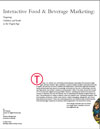 Interactive Food & Beverage Marketing: Targeting Children and Youth in the Digital Age (pdf) Interactive Food & Beverage Marketing: Targeting Children and Youth in the Digital Age (pdf) 
REPORT from the Berkeley Media Studie Group
This report looks at the practices of food and beverage industry marketers in reaching the youth of America - specifically African American and Lation youth - via digital videos, cell phones and interactive games and social networking sites. The piece also provides recommended steps to limit marketing to children and adolescents so that today's media culture can "serve the health of our children rather than undermine it."
|
 |
 Neighborhood Characteristics Associated with the Location of Food Stores and Food Service Places Neighborhood Characteristics Associated with the Location of Food Stores and Food Service Places 
SCHOLARLY ARTICLE by Kimberly Morland, et al. American Journal of Preventative Medicine This study examines the distribution of food stores and food service places by neighborhood wealth and racial segregation. It finds that, compared to the poorest neighborhoods, large numbers of supermarkets and gas stations with convenience stores are located in wealthier neighborhoods. There are three times fewer places to consume alcoholic beverages in the wealthiest compared to the poorest neighborhoods. Regarding neighborhood segregation, there are 4 times more supermarkets located in white neighborhoods compared to black neighborhoods.
|
 |
 Obesity, diets, and social inequalities Obesity, diets, and social inequalities 
SCHOLARLY ARTICLE by Adam Drewnowski, Nutrition Reviews, April 2009 This economic analysis of obesity concludes that inequitable access to healthy foods is one mechanism by which socioeconomic factors influence the diet and health of a population. As incomes drop, energy-dense foods that are nutrient poor become the best way to provide daily calories at an affordable cost. By contrast, nutrient-rich foods and high-quality diets not only cost more but are consumed by more affluent groups. This article discusses obesity as an economic phenomenon. Obesity is the toxic consequence of economic insecurity and a failing economic environment.
|
 |
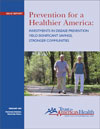 Prevention for a Healthier America: Investments in Disease Prevention Yield Significant Savings, Stronger Communities (pdf) Prevention for a Healthier America: Investments in Disease Prevention Yield Significant Savings, Stronger Communities (pdf) 
REPORT developed in a partnership of the Trust for America’s Health, The Urban Institute, The New York Academy of Medicine, the Robert Wood Johnson Foundation, The California Endowment, and Prevention Institute. Feb 2009
This study examines how much the country could save in health care costs if we invested more in disease prevention, specifically by funding proven community-based programs that result in increased levels of physical activity, improved nutrition (both quality and quantity of food), and a reduction in smoking and other tobacco use rates.bolsos imitacion |
 |
 Promoting Health Equity: A Resource to Help Communities Address Social Determinants of Health (pdf) Promoting Health Equity: A Resource to Help Communities Address Social Determinants of Health (pdf) 
WORKBOOK - Centers for Disease Control and Prevention, 2008 This workbook is for community-based organizations seeking to affect the social determinants of health through community-based participatory approaches and nontraditional partnerships. Along with an introduction to the concepts of health equity, the workbook presents case studies of communities working at both small and large scales. The authors then provide guidelines for developing your own initiative, from creating partnerships to identifying your approach to assessing and maintaining your progress. |
 |
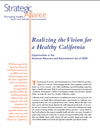 Realizing the Vision for a Healthy California (pdf) Realizing the Vision for a Healthy California (pdf) 
POLICY BRIEF from Strategic Alliance, 2009
The Strategic Alliance for Healthy Food and Activity Environments has developed recommendations for taking advantage of opportunities from the American Recovery and Reinvestment Act of 2009 to improve the health and safety of all Californians.
|
 |
 Ron Sims: The King County Equity and Social Justice Initiative Ron Sims: The King County Equity and Social Justice Initiative 
TRANSCRIPT of a speech by Rom Sims, King County Executive, March 2008 In a speech for the CDC Health Transformation Lecture Series, Mr. Sims explains how his office has made health equity central to its work - across sectors and in partnership with communities, business, and local agencies - and makes the case for the CDC to use its considerable influence and reach to promote and support health equity nationally. |
 |
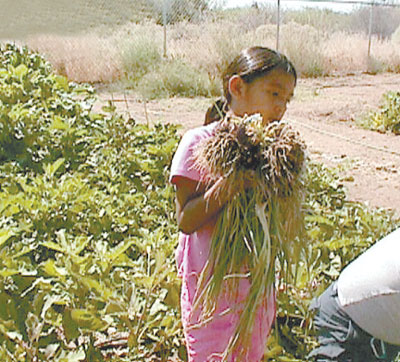 Savoring the Future - Upscale Restaurant Supports Gila River Farming Revival Savoring the Future - Upscale Restaurant Supports Gila River Farming Revival 
NEWS ARTICLE in Indian Country Today With the return of their water in a landmark settlement, the Pima Indians of southern Arizona are returning to their agricultural roots. Upscale eateries like Kai Restaurant on the edge of the Gila River Indian Community reservation are working with tribal farmers to obtain local, seasonable produce - a win-win situation for chefs and growers alike. |
 |
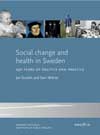 Social change and health in Sweden - 250 years of politics and practice Social change and health in Sweden - 250 years of politics and practice 
BOOK by Jan Sundin and Sam Willner, Swedish National Institute of Public Health, 2008 This thorough text examines the history of public health in Sweden, with particular attention to the emergence of the welfare state in the past century. Say the authors, "Historical lessons cannot be transferred uncritically from one country to another. However, differences and similarities in appropriate contexts can increase our understanding of relations between health and society. We hope that this book will be useful for policy comparisons and in the training of public health policy-makers, researchers, administrators and practitioners."
Full pdf available online, 5 MB. |
 |
 Strategic Alliance for Healthy Food and Activity Environments Strategic Alliance for Healthy Food and Activity Environments 
WEB SITE The Strategic Alliance is a coalition of nutrition and physical activity advocates in California, working to shift the debate on nutrition and physical activity away from a primary focus on personal responsibility and individual choice to one that examines corporate and government practices and the role of the environment in shaping eating and activity behaviors. The Alliance's goal is to benefit the health and wellness of all California residents by promoting environmental solutions and institutional and government policies and practices that support healthy eating and activity. |
 |
 Strategic Review of Health Inequalities in England Post 2010 Strategic Review of Health Inequalities in England Post 2010 
WEB SITE Professor Sir Michael Marmot has been asked by the British government to Chair an independent Review to propose the most effective strategies for reducing health inequalities in England from 2010. This review is a response to the recommendation of the WHO Commission on Social Determinants of Health that national governments develop and implement strategies and policies suited to their particular national context aimed at improving health equity. |
 |
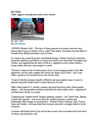 Study suggests economic insecurity boosts obesity Study suggests economic insecurity boosts obesity 
Reuters In a study in the journal Economics and Human Biology, Oxford University researchers found that Americans and Britons are much more likely to be obese than Norwegians and Swedes, and suggested that the stress of life in a competitive social system without a strong welfare state may cause people to overeat.
"Policies to reduce levels of obesity tend to focus on encouraging people to look after themselves, but this study suggests that obesity has larger social causes," said Avner Offer, a professor of economic history who led the study. |
 |
 The Cost of Healthy Eating The Cost of Healthy Eating 
GRAPH, David Leonhardt, New York Times, May 20, 2009 This chart illustrates that the cost of many unhealthful foods (like soda, butter and beer) has fallen in the last three decades while the cost of fruits and vegetables has risen substantially.
This graph was featured in David Leonhardt's May 20 column, "Sodas a tempting tax target." A more detailed version of the chart appears on the author's Economix blog entry of the same date. |
 |
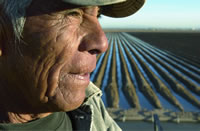 The New Water Czars The New Water Czars 
NEWS ARTICLE from the High Country News, March 15, 2004 This article describes the history and implications of the historic Arizona Water Rights Settlement Act of 2004, guaranteeing river water to the impoverished Pima and Maricopa Indian communities. |
 |
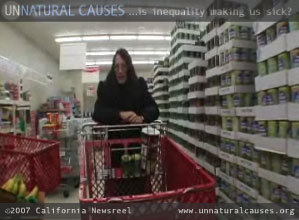 There's No Such Thing as Small Stuff: Being Poor in Louisville There's No Such Thing as Small Stuff: Being Poor in Louisville 
WEB-EXCLUSIVE VIDEO, Unnatural Causes Mary Turner, featured in "In Sickness and In Wealth," lives in a poor neighborhood of Louisville, KY. With three teenage children, a husband on disability, and health complications that prevent her from working, Mary must budget carefully to keep her family fed and housed. In this video, she discusses the choices she faces every day, quickly but eloquently presenting a glimpse of one woman's life at the lower end of the U.S. socio-economic spectrum. |
 |
 Tohono O'odham Community Action (TOCA) Tohono O'odham Community Action (TOCA) 
WEB SITE TOCA is a community- based organization dedicated to creating cultural revitalization, community health and sustainable development on the Tohono O'odham Nation. TOCA was founded in 1996 as a non-profit organization. TOCA has adopted principles that represent our approach to community development and guide our programs. |
 |
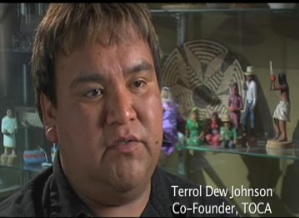 Tohono O'odham Community Action (TOCA) - Cultural Renewal to Improve Health Tohono O'odham Community Action (TOCA) - Cultural Renewal to Improve Health 
WEB-EXCLUSIVE VIDEO, Unnatural Causes Terrol Dew Johnson, featured in the "Bad Sugar" segment of UNNATURAL CAUSES, is co-founder of TOCA, a community-based organization focused on cultural renewal as key to empowerment and better health. TOCA has four primary program areas: basketweaving, traditional foods, youth/elder outreach and traditional arts and culture.
replica uhren
breitling replica |
 |
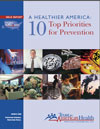 Top Ten Priorities for Prevention Top Ten Priorities for Prevention 
ISSUE REPORT, Trust for America's Health TFAH has identified 10 key policy areas where government action could improve the health of the U.S. population and lower the costs associated with treating people after they're already sick:
- Promoting Disease Prevention
- Combating the Obesity Epidemic
- Preventing Tobacco Use and Exposure
- Preventing and Controlling Infectious Diseases
- Preparing for Potential Health Emergencies and Bioterrorism Attacks
- Recognizing the Relationship Between Health and U.S. Economic Competitiveness
- Safeguarding the Nation's Food Supply
- Planning for Changing Health Care Needs of Seniors
- Improving the Health of Low-Income and Minority Communities
- Reducing Environmental Threats
And a crosscutting recommendation for:
- Holding Government Accountable for Protecting the Health of Americans
|
 |
| « Prev 1 | 2 |
|




